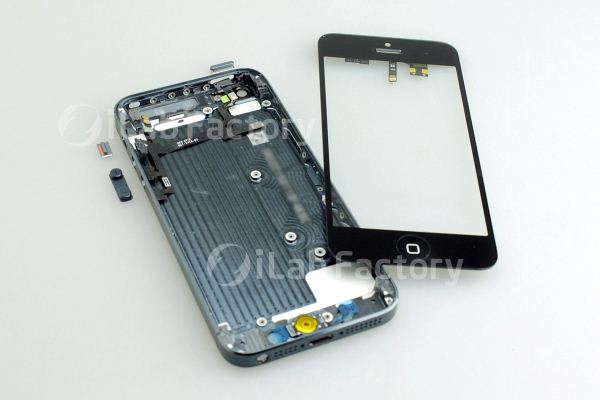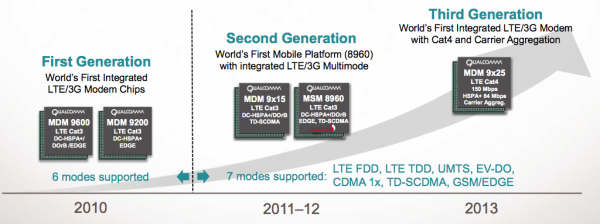
Original Link: https://www.anandtech.com/show/6196/preparing-for-the-iphone-next-rumors-analyzed
Preparing for the iPhone Next: Rumors Analyzed
by Brian Klug & Anand Lal Shimpi on August 27, 2012 9:40 PM EST- Posted in
- Apple
- Smartphones
- Mobile
- iPhone
While we typically don't comment on rumors we don't know to be true at AnandTech, we often get requests to help set rational expectations ahead of major iDevice launches. The shroud of secrecy around major Apple launches can pave the way for both sensible and unrealistic conclusions.
Given the growth of Apple's iPhone/iPad devices, it has become increasingly difficult for suppliers in the chain to remain mum about any changes. Similar to how we often get early access to CPUs, motherboards and other components out of Taiwan, it has become increasingly commonplace to see leaks of iDevice components out of the big ODMs in China.
Apple is largely expected to launch its sixth iPhone next month. The historical cadence of design, SoC, and cellular changes are in the table below:
| Apple iPhone - Historical Trends | |||||||
| Release Year | Industrial Design | CPU Architecture | GPU Architecture | Cellular Architecture | |||
| iPhone | 2007 | 1st gen | ARM11 | MBX-lite | Infineon S-Gold 2 | ||
| iPhone 3G | 2008 | 2nd gen | ARM11 | MBX-lite | Infineon X-Gold 608 | ||
| iPhone 3GS | 2009 | 2nd gen | Cortex A8 | SGX-535 | Infineon X-Gold 608 | ||
| iPhone 4 | 2010 | 3rd gen | Cortex A8 | SGX-535 | Infineon X-Gold 618 in 4 GSM / Qualcomm MDM6600 in 4 CDMA | ||
| iPhone 4S | 2011 | 3rd gen | 2 x Cortex A9 | SGX-543MP2 | Qualcomm MDM6610 (MDM6600 w/ ext. trans) | ||
| iPhone Next | 2012 | ? | ? | ? | ? | ||
Trends are pretty easy to spot in the table. With the exception of the first iPhone, the industrial design appears to be on a 2-year cadence. The CPU and GPU architectures are also on the same 2-year cadence. From a silicon standpoint even the cellular architecture is trending towards the same 2-year cadence, with a few notable exceptions (e.g. GSM/CDMA iPhone 4 divide).
Based on historical trends alone it's pretty easy to conclude that we'll see a 4th generation chassis, a pair of ARM Cortex A9s and a PowerVR SGX 543MP2 under the hood. Add the assumption of LTE (a reasonable one to make) and you have a pretty believable story. It turns out the currently available evidence helps corroborate this, but let's dig through what's out there to see how this all fits.
Chassis & Display
The chassis is largely a known quantity by this point. Enough examples out of China have surfaced to support the current working theory of a 4-inch diagonal (16:9) display in a slightly taller chassis with roughly the same width. Put simply, it's a new taller aspect ratio, which also has the consequence of including a larger 4-inch, 640 x 1136 display. The result is a change only in one dimension for developers to worry about.
The other big rumored change is a move from on-cell touch sensing (which places the drive and detect ITO layers above the LCD assembly) to an in-cell touch solution. In-cell being the operative word because the drive layers are integrated into the LCD gating (or use it natively), or on the color filter layer. There's some debate about what counts as on-cell and in-cell that isn't quite settled, but ultimately what it boils down to is a thinner display stack that will contribute significantly to the reduction in overall device thickness that is rumored for the upcoming iPhone.
While the industrial design remains quite similar at a high level, there do appear to be some major changes. Where the 4 and 4S designs used front and back glass with an external metal band for support, the leaked designs out of China feature a metal unibody construction with cutouts for RF windows at top and bottom. There's enough evidence of this from the CNC machine marks visible on examples, and moreover moving to a larger form factor requires a beefier chassis.
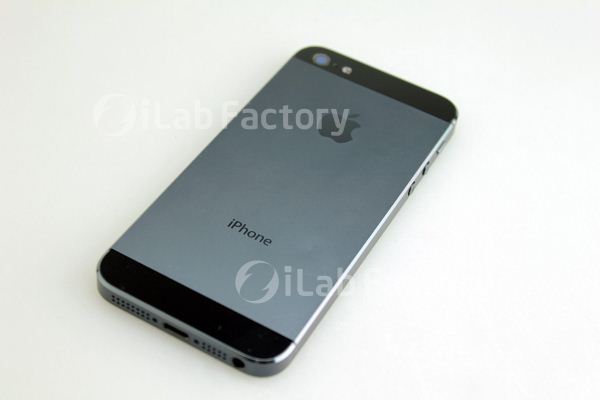
Black regions at top and bottom are likely RF window cutouts
With top and bottom RF windows (which appear to be glass) there shouldn't be any implications on antenna performance for cellular. If you followed our coverage of the evolution of Apple's cellular antenna design from the iPhone 4 GSM, to 4 CDMA, to 4S, you'll notice that this is a clear next step, largely inheriting the top/bottom antenna split from the 4S which fully mitigated deathgrip. Interestingly enough the exterior band appears to have a different chrome finish rather than the matte stainless steel of previous designs.
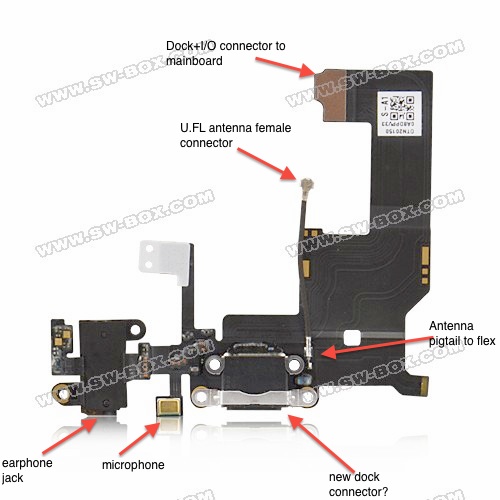
Bottom flex cable, annotations ours
Other things like moving the 3.5mm headphone jack to the bottom of the device and the mini 9-pin dock connector are fairly well corroborated by leaks with components that all fit together inside the case. Interestingly enough, parts indicating the mini dock connector and relocated headphone jack have been circulating for nearly 4 months.
The SoC: 32nm A5R2?
So much of any new iPad/iPhone release is tied to the SoC. Apple remains one of the only handset designers that aggressively specs its own SoC rather than picking up an off the shelf part. As of late, Apple has used its control over its own SoC architecture to better match its chip architectures to the needs of its high resolution displays. Apple continues to produce its custom-designed SoCs at Samsung, although it's likely that Apple will consider other foundries at the 20nm node.
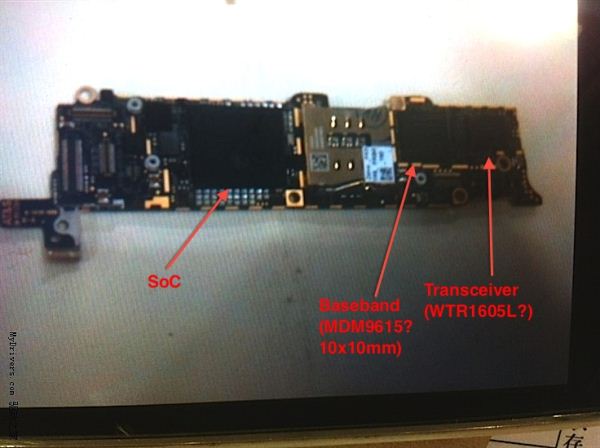
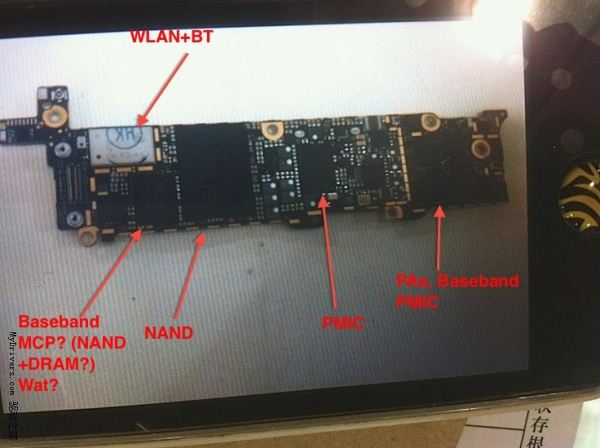
Rumored upcoming PCB, annotations ours
Most early looks at the next iPhone's internals show no silkscreened part numbers on the SoC. We've already seen blurry photos of the suspected upcoming PCB leak, though they're far too low quality to make out any chip markings. Given Apple's history, it's likely we'll see a 32nm LP (HK+MG) variant of the A5 SoC used in the iPhone 4S - perhaps at higher clocks. The move to a smaller process node should bring about a tangible increase in battery life. Depending on the workload, the iPhone 4S could burn more power than the iPhone 4 thanks to its beefy CPU + GPU combination. The move to 32nm could easily offset this penalty.
We've seen Apple experiment with Samsung's 32nm LP process in the past. Both the current generation Apple TV and the iPad 2,4 use a 32nm A5. In the case of the iPad 2,4, we saw a huge increase in battery life as a result of the move to 32nm. Some of the gains in battery life in the iPhone are likely to be offset by higher CPU/GPU clocks, but this is still the most likely approach for Apple this generation.
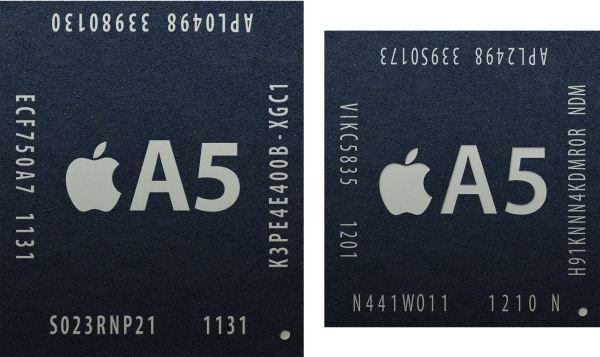
Original A5 (45nm, S5L8940, left), A5R2 (32nm, S5L8942, right)
As we mentioned back during our review of the iPad 2,4, it makes sense to test a new/unfamiliar process on a low volume part. By shipping 32nm A5 SoCs into some iPad 2s and the Apple TV (a hobby product), Apple could ride the 32nm yield curve up without adversely impacting shipments of its key money makers. With Samsung's 32nm LP process likely seeing much better yields now, it's time to deploy it in the next iPhone. Given much of the competition has moved to TSMC's 28nm process, Apple must remain competitive on the process node front as well. Shipping a 45nm SoC at the end of 2012 simply doesn't make sense. Although the current legal battles with Samsung could impact the relationship on the foundry side, simply switching to Global Foundries or TSMC is easier said than done. I would expect Apple to go through the same careful transition between Samsung and any other foundry as it did when it introduced the first 32nm A5s into the mix. The current expectations here are that we'll see Apple look at TSMC at the 20nm node.
With process node pretty much guaranteed, there's the question of CPU and GPU architectures.
Since the release of the original iPad, Apple has used the spring to introduce new SoC architectures in the iPad and later waterfall them down to the iPhone in the summer/fall. The A5X in the 3rd generation iPad however is still built on Samsung's 45nm LP process and is huge as a result of integrating four PowerVR SGX543 cores and implementing a 4 x 32-bit memory interface. The A5X needed the GPU power and memory bandwidth to drive the new iPad's retina display, but that power would be largely lost on the next iPhone.
The new iPhone is expected to have a 640 x 1136 resolution, thanks to its taller 4-inch display, but that's only 18% more pixels than the current iPhone 4S. A doubling of memory bandwidth and GPU compute horsepower would seem a bit excessive for current workloads. A ~20% increase in GPU clock speed, and faster DRAM would be enough to maintain current levels of performance on the higher resolution display.
Apple decoupled major cellular architecture and CPU architecture shifts in the past (e.g. iPhone 3G/3GS transition), which lends credibility to the idea of a move to A15 next year with the 4th gen iPad and sticking with the dual-core A9 design for the next iPhone. There's also the fact that TI is expected to be one of the first to bring an ARM Cortex A15 based SoC to market, and even it hasn't demonstrated an OMAP 5 running at shipping CPU clocks yet. I don't doubt that it's possible to ship an A15 based SoC before the end of the year, but based on the demos we've seen thus far, it seems highly unlikely to see one shipping in Q3. Apple doesn't like to be overly risky on the component front. There's nothing worse than a poorly yielding or otherwise problematic chip holding up shipments of one of your biggest revenue generators.
Cellular Connectivity: LTE Expected
The iPhone has always used separate applications and baseband processors. The next model is not expected to be any different. The big addition with the upcoming iPhone will be a massive and much needed improvement in cellular connectivity. Put simply, the addition of both support for LTE in the Americas and perhaps a few other international markets, and TD-SCDMA support for China. Support for LTE is simply requisite for a high end smartphone at this point, and inclusion of TD-SCDMA is likewise requisite for any further growth in China.
The commercial availability of Qualcomm's second generation Gobi modems and transceivers will make this possible without the design caveats posed by the previous generation of LTE basebands. Specifically, caveats such the lack of a built in codec for voice, requiring the so-called Qualcomm SoC fusion scenario that required MDM9x00 to ship in conjunction with a Qualcomm SoC to enable voice (whereas MDM9x15 is natively voice enabled). That's to say nothing of power draw which improved over time for MDM9x00 with software improvements (such as inclusion of more DRX features), but still precluded inclusion in an iPhone without a battery penalty. There's a reason you see MDM9x00 in the iPad 3 with WiFi but not in the iPhone 4S, even though it was available for that product's release.
The part we've fingered for baseband in the next iPhone is Qualcomm's MDM9x15 platform, which is a 28nm TSMC device that includes support for Category 3 LTE TDD and FDD, up to Release 8 42 Mbps DC-HSPA+, GSM/EDGE, TD-SCDMA, and CDMA2000 1x, 1xAdvanced, and EVDO on the MDM9615 variant. This is the same IP block as what is already inside shipping MSM8960 SoCs and devices today, where we've seen great battery life and LTE performance. There's one further improvement as well which MDM9615 hopefully will have over the current MSM8960 implementation, and that's the inclusion of a new 28nm RF (as opposed to logic) transceiver named WTR1605, instead of the 65nm RTR8600. This new transceiver also includes even more ports (7 instead of 5 on RTR8600) which means we will see likely more 3G or 4G LTE bands supported in this upcoming device. Even without that improvement we'll see inclusion of LTE without any caveats.
Because 2x2 MIMO is mandatory for LTE Category 2 and above (and 2 receive diversity mandatory for all LTE categories), you can see how that top bottom RF window and antenna split we touched on earlier makes even more sense. Again, this isn't a big leap from the iPhone 4S which already features both receive and transmit diversity split between top and bottom antennas, but just further fits into the LTE iPhone puzzle.
A small note under the cellular category is that this will also likely continue to be where GNSS (GPS and GLONASS) resides, something the CDMA iPhone 4 and 4S both already have courtesy the MDM66x0 baseband inside. MDM9x15 bumps this slightly, from Qualcomm's GPSone with GLONASS generation 8 to 8A, though I'm not certain what all improvements come from that change in version.
NFC, Unlikely
The most recent rumor is that this mysterious square chip (occluded by an EMI can) is an NFC combo controller and antenna, based purely on its square dimensions.
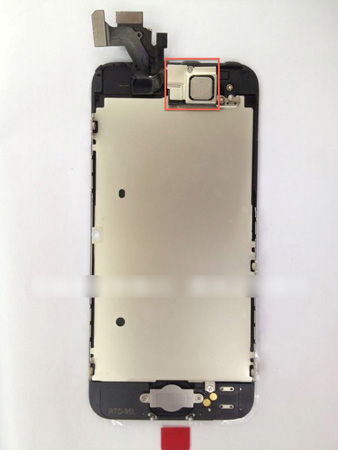
The NFC "chip" ensquared in red
Given the primarily metal backside of the new iPhone, it's highly unlikely that NFC is in the cards for this generation. In fact, given the very little space at top and bottom dedicated to those glass RF windows, you can almost entirely rule it out.
NFC operates on the 13.56MHz ISM band, which has a relatively large wavelength, at 22.1 m. Making a traditional dipole antenna that radiates at all given the constraints of a smartphone package is thus a big challenge, considering that smartphones are maybe 5-inches tall at maximum, to say nothing of the supposed upcoming iPhone's longest linear dimension.
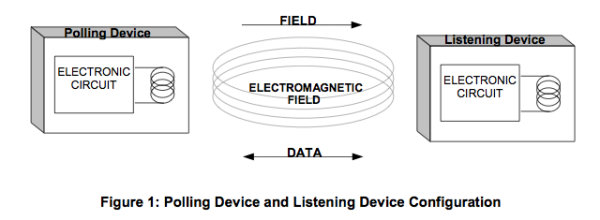
From the NFC Forum Analog Specification
As a result almost all NFC antennas are big inductors and work using a magnetic field coupled between a host and peer device. Since we're talking about an inductor, NFC antennas use as big of a coil of wire as possible with as many wires as possible tightly wound together, and thus often use as big of an unbroken 2D plane as they can get on the device. In the smartphone space, basically all NFC antennas to date are simply flat spirals on a PCB. Whether this gets hidden on top of the battery like what Samsung has done in recent devices, or printed on the back battery cover like earlier devices, the antenna is ultimately a big square or circle with as big and dense of a coil as possible.
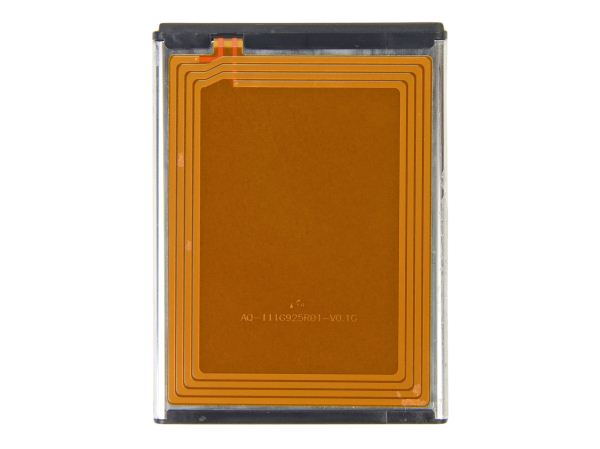
Galaxy Nexus Battery and NFC Antenna Coils (Courtesy iFixit)
Getting a good inductor into the device is important because how much inductance your antenna has will determine maximum coupling distance and ease of alignment. It shouldn't need saying, but having a huge ground plane (the unibody metal back case) in the way of your NFC antenna will seriously degrade performance, thus only the top or bottom windows are logical places to put it.
It's this last point which makes us very skeptical about the top or bottom RF windows being used for a relatively small NFC loop – not because such a thing is impossible – but rather because of how terrible the resulting ease of alignment and maximum coupling distance would be. Most NFC implementations at present place the inductive coils as near to the center of the device as possible, partly because this is the most optimal way to maximize the area which can be dedicated to it, partly because it makes alignment natural. With an NFC antenna at the extreme top or bottom, alignment with non-iPhones (for example, payment tokens or reader tags) becomes a much more confusing task, and that doesn't seem like the Apple-like level of polish everyone is waiting for to drive NFC adoption.
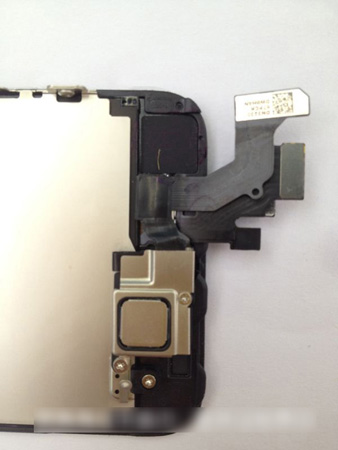
There's also a healthy number of signaling pins in the flex cable leaving the mystery chip, some of which appear to be signaling for the front facing camera which is part of the assembly, others for earpiece, proximity, and ambient light sensor. In addition this assembly also is obviously the assembled display and touch stack. When you consider the inclusion of in-cell touch sensing which has been rumored for the upcoming iPhone, and the requirement for time multiplexing of both display driving and touch sensing signals (to mitigate interference and make this possible), it's more likely that the components under that heavily shielded (and grounded with a big spring finger) EMI can are the touch and display controller combo that need to work in conjunction for in-cell to be possible.
The inclusion of Passbook in iOS 6 is the most often-cited piece of evidence for Apple including NFC, which seems a bit paradoxical since Apple hasn't disclosed at all whether it would favor NFC or a Bluetooth LE (low-energy) or even QR code based payment token through that gateway.
WiFi
Improvements to WiFi come every generation partly just due to better combo chips coming from Broadcom's aggressive roadmap in that space, and we wouldn't be surprised to see further generational improvement here. If you read our reviews, this will sound like a broken record, but the inclusion of 5 GHz WiFi support in smartphones is something that is starting to become relatively mainstream at the high end, and we wouldn't be shocked to see the iPhone follow suit.
The location of that antenna moved from the external metal band on the GSM iPhone 4 to an internal printed one with the CDMA iPhone 4 so that the top band could be repurposed for cellular receive diversity, something the 4S inherited. I would strongly expect that to continue with the next device given the aforementioned MIMO requirements for LTE. Multi spatial stream support for WiFi is still basically out of the question, improvements in this space are again possible 5 GHz support with 40 MHz channels, which we've seen from BCM4334 in other shipping devices already.
| Apple iPhone - WiFi Trends | |||||||
| Release Year | WiFi + BT Support | WiFi Silicon | |||||
| iPhone | 2007 | 802.11 b/g, BT 2.0+EDR | Marvell W8686, CSR BlueCore | ||||
| iPhone 3G | 2008 | 802.11 b/g, BT 2.0+EDR | Marvell W8686, CSR BlueCore | ||||
| iPhone 3GS | 2009 | 802.11 b/g, BT 2.1+EDR | Broadcom BCM4325 | ||||
| iPhone 4 | 2010 | 802.11 b/g/n (2.4GHz), BT 2.1+EDR | Broadcom BCM4329 | ||||
| iPhone 4S | 2011 | 802.11 b/g/n (2.4GHz), BT 4.0+EDR | Broadcom BCM4330 | ||||
| iPhone Next | 2012 | ? | Broadcom BCM4334? | ||||
Battery
Battery life on a device is obviously a function of the inherent efficiency of its components, but also is a function of overall battery capacity. Increasing the size of that tank obviously gets you immediate gains in overall lifetime, at the expense of increasing the mass or volume of the device. The iPhone has been no stranger to increases in battery life, and in fact the iPhone 4 realized a considerable jump in overall battery size thanks to the side by side PCB / battery split that has now dominated smartphone design. Since then we haven't seen as much of an increase in capacity, and meanwhile some Android phones are shipping batteries as large as nearly 8 Whr (2100 MaH, 3.8V in SGS3).
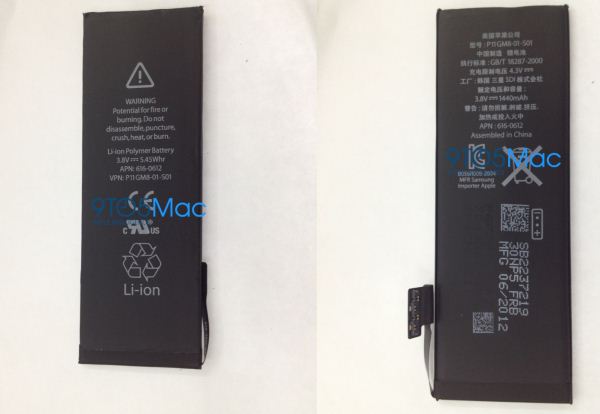
Higher capacity iPhone Battery (courtesy: 9to5Mac)
Recent leaks out of China have, howver, indicated that the next iPhone will likely move to a higher voltage chemistry, up from 3.7 V nominal to 3.8 V nominal. This follows the move that Motorola made over a year ago to the 3.8 V nominal chemistry where I saw it the first time. Since then Motorola has shipped almost all its phones with 3.8 V batteries, followed by Nokia and Samsung. Thus it seems highly likely that Apple will also move to this chemistry given maturity and the tangible benefits it provides to battery lifetime.
| Apple iPhone - Battery Trends | |||||||
| Release Year | Battery | ||||||
| iPhone | 2007 | 1400 mAh, 3.7V (5.18 Wh) | |||||
| iPhone 3G | 2008 | 1150 mAh, 3.7V (4.25 Wh) | |||||
| iPhone 3GS | 2009 | 1219 mAh, 3.7V (4.51 Wh) | |||||
| iPhone 4 | 2010 | 1420 mAh, 3.7V (5.25 Wh) | |||||
| iPhone 4S | 2011 | 1430 mAh, 3.7V (5.29 Wh) | |||||
| iPhone Next | 2012 | 1440 mAh, 3.8V (5.47 Wh) | |||||
Conclusions
Based on everything we've seen, and the analysis on the previous pages, it seems likely that the next iPhone will feature a dual-core Cortex A9 SoC built on Samsung's 32nm LP (HK+MG) process, with a PowerVR SGX 543MP2 driving a larger 4-inch display. Battery capacity will see a slight bump, but battery life itself should be measurably better compared to the iPhone 4S thanks to a move to 28/32nm silicon for the baseband and apps processor. LTE and TD-SCDMA support will likely be driven by a Qualcomm MDM9x15. Evolutionary improvements in the WiFi stack are a reasonable expectation, however NFC support isn't. There are still questions about final details (e.g. camera sensors) but a lot of what Apple has been doing with the iPhone closely follows an aggressive 2-year design and silicon cadence. It's the relentless competition and hyper Moore's Law curve in the smartphone space that drive Apple's development cycle here. I don't expect much change here for the next couple of years at least.
Despite the annual release schedule and a 2-year cadence for most silicon elements, Apple also appears to remain relatively conservative in how it adopts new technologies. Process nodes, new chip architectures, and new wireless standards are all evaluated with a fairly conservative eye. Apple's iPhone business is a well oiled machine at this point, any unnecessary risks are consistently avoided.

